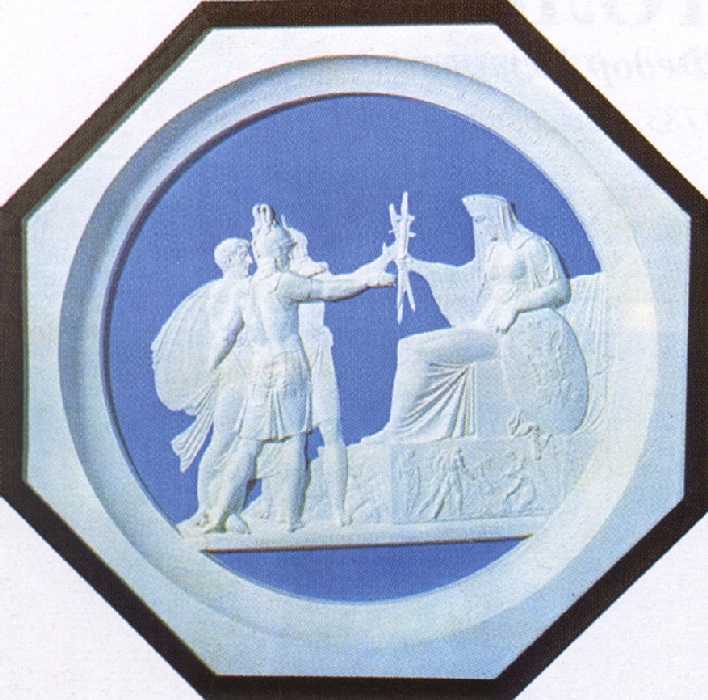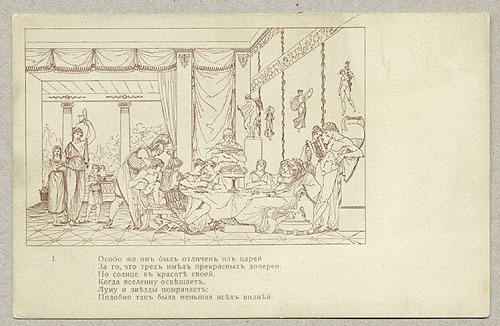Fyodor Petrovich Tolstoy on:
[Wikipedia]
[Google]
[Amazon]
Count Fyodor Petrovich Tolstoy (russian: Фёдор Петрович Толстой; 21 February 1783 – 25 April 1873) was a Russian artist who served as Vice-President of the
 A year later, Fyodor entered the
A year later, Fyodor entered the  In 1838, Tolstoy composed the ballet ''The
In 1838, Tolstoy composed the ballet ''The
Tolstoy's works
at abcgallery.com
Biography
at russianculture.ru
at staratel.com {{DEFAULTSORT:Tolstoy, Fyodor Petrovich 1783 births 1873 deaths Fyodor Petrovich Counts of the Russian Empire Russian painters Russian male painters 19th-century sculptors from the Russian Empire 19th-century male artists from the Russian Empire Russian male sculptors Russian composers Russian male composers Russian memoirists Jesuit College in Polotsk alumni Burials at Lazarevskoe Cemetery (Saint Petersburg) 19th-century memoirists 19th-century male musicians
Imperial Academy of Arts
The Russian Academy of Arts, informally known as the Saint Petersburg Academy of Arts, was an art academy in Saint Petersburg, founded in 1757 by the founder of the Imperial Moscow University Ivan Shuvalov under the name ''Academy of the Thr ...
for forty years (1828–1868). His works – wax-reliefs, watercolours, medallions, and silhouettes – are distinguished by a cool detachment and spare and economical classicism.
Biography
Fyodor Tolstoy came from the Tolstoy family. His father Count Pyotr Andreyevich Tolstoy, governed a ministry of war supplies. Tolstoy early began to paint under the direction of his mother, Elizabeth Barbot-de-Marni. His first drawings, which are now stored in theTretyakov Gallery
The State Tretyakov Gallery (russian: Государственная Третьяковская Галерея, ''Gosudarstvennaya Tretyâkovskaya Galereya''; abbreviated ГТГ, ''GTG'') is an art gallery in Moscow, Russia, which is considered th ...
, were made when he was 4 years old. At the age of nine he went to the foster care
Foster care is a system in which a minor has been placed into a ward, group home ( residential child care community, treatment center, etc.), or private home of a state-certified caregiver, referred to as a "foster parent" or with a family ...
of his rich and influential cousin, Count Pyotr Aleksandrovich Tolstoy.
 A year later, Fyodor entered the
A year later, Fyodor entered the Jesuit College in Polotsk
The Jesuit College in Polotsk ( lat, Collegium Polocense) was a college established by the Jesuit Order in Polotsk, then part of the Grand Duchy of Lithuania and later occupied by the Russian Empire, and now in Belarus. It was established in 1580 a ...
. Here, he studied painting, as well as the sciences. Upon his accession to the throne, Emperor Paul I summoned Pyotr Tolstoy to Saint Petersburg
Saint Petersburg ( rus, links=no, Санкт-Петербург, a=Ru-Sankt Peterburg Leningrad Petrograd Piter.ogg, r=Sankt-Peterburg, p=ˈsankt pʲɪtʲɪrˈburk), formerly known as Petrograd (1914–1924) and later Leningrad (1924–1991), i ...
, and Fyodor Petrovich returned to his parents. At the same time, his father was fired, and the family's circumstances deteriorated.
From June 1798 to June 1802, Fyodor Petrovich was educated in the Naval Cadet Corps. After finishing, he continued his education under the direction of famous scientists. He studied mathematics
Mathematics is an area of knowledge that includes the topics of numbers, formulas and related structures, shapes and the spaces in which they are contained, and quantities and their changes. These topics are represented in modern mathematics ...
, astronomy
Astronomy () is a natural science that studies celestial objects and phenomena. It uses mathematics, physics, and chemistry in order to explain their origin and evolution. Objects of interest include planets, moons, stars, nebulae, g ...
, political economy
Political economy is the study of how economic systems (e.g. markets and national economies) and political systems (e.g. law, institutions, government) are linked. Widely studied phenomena within the discipline are systems such as labour ...
, zoology
Zoology ()The pronunciation of zoology as is usually regarded as nonstandard, though it is not uncommon. is the branch of biology that studies the animal kingdom, including the structure, embryology, evolution, classification, habits, an ...
, archaeology
Archaeology or archeology is the scientific study of human activity through the recovery and analysis of material culture. The archaeological record consists of artifacts, architecture, biofacts or ecofacts, sites, and cultural landsc ...
and numismatics
Numismatics is the study or collection of currency, including coins, tokens, paper money, medals and related objects.
Specialists, known as numismatists, are often characterized as students or collectors of coins, but the discipline also inc ...
. He also frequented the riding academy, and became a dashing horseman.
In this time, without any supervision, he painted still lives, portrait
A portrait is a painting, photograph, sculpture, or other artistic representation of a person, in which the face and its expressions are predominant. The intent is to display the likeness, personality, and even the mood of the person. For this ...
s and landscape
A landscape is the visible features of an area of land, its landforms, and how they integrate with natural or man-made features, often considered in terms of their aesthetic appeal.''New Oxford American Dictionary''. A landscape includes the ...
s. After his father showed him a cameo depicting Napoleon
Napoleon Bonaparte ; it, Napoleone Bonaparte, ; co, Napulione Buonaparte. (born Napoleone Buonaparte; 15 August 1769 – 5 May 1821), later known by his regnal name Napoleon I, was a French military commander and political leader wh ...
, he started to learn the art of the medallist. Tolstoy visited the Imperial Academy of Arts' classes of plastic arts. One of his teachers was the most fashionable Russian portraitist of the time, Orest Kiprensky
Orest Adamovich Kiprensky (russian: Орест Адамович Кипренский -) was a leading Russian portraitist in the Age of Romanticism. His most familiar work is probably his portrait of Alexander Pushkin (1827), which prompted the ...
.
In 1804, Fyodor Tolstoy was appointed an adjutant
Adjutant is a military appointment given to an officer who assists the commanding officer with unit administration, mostly the management of human resources in an army unit. The term is used in French-speaking armed forces as a non-commission ...
of Admiral Pavel Chichagov, and was forced to retire. From 1806 he worked in the Hermitage Museum
The State Hermitage Museum ( rus, Государственный Эрмитаж, r=Gosudarstvennyj Ermitaž, p=ɡəsʊˈdarstvʲɪn(ː)ɨj ɪrmʲɪˈtaʂ, links=no) is a museum of art and culture in Saint Petersburg, Russia. It is the larges ...
. In 1806, he painted the ''Confidence of Alexander of Macedon to doctor Philippos'', the '' Judgement of Paris'', the ''Labours of Hercules'', etc. For his wax bas-relief
Relief is a sculptural method in which the sculpted pieces are bonded to a solid background of the same material. The term '' relief'' is from the Latin verb ''relevo'', to raise. To create a sculpture in relief is to give the impression that th ...
the ''Triumphal entrance of Alexander of Macedon into Babylon
''Bābili(m)''
* sux, 𒆍𒀭𒊏𒆠
* arc, 𐡁𐡁𐡋 ''Bāḇel''
* syc, ܒܒܠ ''Bāḇel''
* grc-gre, Βαβυλών ''Babylṓn''
* he, בָּבֶל ''Bāvel''
* peo, 𐎲𐎠𐎲𐎡𐎽𐎢 ''Bābiru''
* elx, 𒀸𒁀𒉿𒇷 ''Babi ...
'' (1809, now in the Hermitage Museum), Tolstoy was elected an honorable member of the Academy of Arts.
Starting 23 September 1810 he worked in the Department of the Mint and became the founder of medal working in Russia
Russia (, , ), or the Russian Federation, is a transcontinental country spanning Eastern Europe and Northern Asia. It is the largest country in the world, with its internationally recognised territory covering , and encompassing one-ei ...
. After the battle of Leipzig
The Battle of Leipzig (french: Bataille de Leipsick; german: Völkerschlacht bei Leipzig, ); sv, Slaget vid Leipzig), also known as the Battle of the Nations (french: Bataille des Nations; russian: Битва народов, translit=Bitva ...
, he began a series of twenty-four medallions, devoted to the major battles of the Napoleonic Wars
The Napoleonic Wars (1803–1815) were a series of major global conflicts pitting the French Empire and its allies, led by Napoleon I, against a fluctuating array of European states formed into various coalitions. It produced a period of Fre ...
. Tolstoy's medallions acquired wide reputation not only in Russia, but also abroad. He was elected a member of almost all the European academies of fine arts. In 1861, he made his last medal, dedicated to the emancipation of the serfs.
From 1820 to 1833, he employed the Neoclassical technique of "raw sketch," or refined outline drawings without shading and hatchwork, to execute 63 illustrations for the ''Dushenka'' of Ippolit Bogdanovich. As regards painting, Tolstoy specialized in interior scenes, full of symmetrical lines and Neoclassical statuary. His ''Family Portrait'' (1830) "betrays a Romantic fascination with both psychological detail and tricks of lighting, perspective, and frames".
In 1816, he became involved in freemasonry
Freemasonry or Masonry refers to fraternal organisations that trace their origins to the local guilds of stonemasons that, from the end of the 13th century, regulated the qualifications of stonemasons and their interaction with authorities ...
, eventually participating in the organization of the so-called " Lancasterian schools," designed to propagate literacy. Although he was close to the founding fathers of the Decembrist societies, Tolstoy did not participate in their unsuccessful revolt. In 1826, he wrote two treatises for Nicholas I, ''About the moral state of troops of Russia'' and ''About the state of the Russian Empire in connection to its internal organization'', in which he proposed a series of legislative, social and tax reforms.
 In 1838, Tolstoy composed the ballet ''The
In 1838, Tolstoy composed the ballet ''The Aeolian Harp
An Aeolian harp (also wind harp) is a musical instrument that is played by the wind. Named for Aeolus, the ancient Greek god of the wind, the traditional Aeolian harp is essentially a wooden box including a sounding board, with strings stretched ...
''. He wrote the libretto
A libretto (Italian for "booklet") is the text used in, or intended for, an extended musical work such as an opera, operetta, masque, oratorio, cantata or musical. The term ''libretto'' is also sometimes used to refer to the text of major li ...
, carried out sketches for costumes, and, in more than sixty pictures, determined the choreography. In 1842, he composed a second ballet, based on Greek myth, ''Echo''. Unfortunately, neither of them was mounted.
In 1843 his daughter Ekatarina Fedorovna Tolstoya was born. She would become a painter and marry Professor Eduard Junge.
Pushkin
Alexander Sergeyevich Pushkin (; rus, links=no, Александр Сергеевич ПушкинIn pre-Revolutionary script, his name was written ., r=Aleksandr Sergeyevich Pushkin, p=ɐlʲɪkˈsandr sʲɪrˈɡʲe(j)ɪvʲɪtɕ ˈpuʂkʲɪn, ...
, who regarded Tolstoy as the finest of contemporary Russian artists, referred to him, not surprisingly, in his novel ''Eugene Onegin
''Eugene Onegin, A Novel in Verse'' (Reforms of Russian orthography, pre-reform Russian: ; post-reform rus, Евгений Оне́гин, ромáн в стихáх, p=jɪvˈɡʲenʲɪj ɐˈnʲeɡʲɪn, r=Yevgeniy Onegin, roman v stikhakh) is ...
''. In an 1825 letter to his brother, Pushkin asked him to procure a vignette for the new edition of his poems: "What about having it done by Tolstoy's magic brush? ''No - too expensive, but how terrifically sweet''" (the last line is taken from Ivan Dmitriev
Ivan Ivanovich Dmitriev ( rus, Ива́н Ива́нович Дми́триев, p=ɪˈvan ɪˈvanəvʲɪdʑ ˈdmʲitrʲɪjɪf, a=Ivan Ivanovich Dmitriyev.ru.vorb.oga; – ) was a Russian statesman and poet associated with the sentimentalist ...
's fable "The Fashionable Woman").Vladimir Nabokov
Vladimir Vladimirovich Nabokov (russian: link=no, Владимир Владимирович Набоков ; 2 July 1977), also known by the pen name Vladimir Sirin (), was a Russian-American novelist, poet, translator, and entomologist. Bor ...
. ''Eugene Onegin: A Novel in Verse: Commentary''. Princeton University Press, 1991. . Page 443.
References
*External links
Tolstoy's works
at abcgallery.com
Biography
at russianculture.ru
at staratel.com {{DEFAULTSORT:Tolstoy, Fyodor Petrovich 1783 births 1873 deaths Fyodor Petrovich Counts of the Russian Empire Russian painters Russian male painters 19th-century sculptors from the Russian Empire 19th-century male artists from the Russian Empire Russian male sculptors Russian composers Russian male composers Russian memoirists Jesuit College in Polotsk alumni Burials at Lazarevskoe Cemetery (Saint Petersburg) 19th-century memoirists 19th-century male musicians